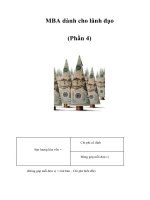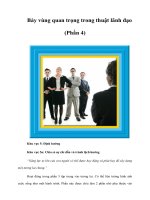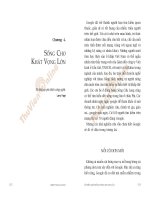LEADERSHIP STRATEGIES FOR PERSONAL SUCCESS phần 4 docx
Bạn đang xem bản rút gọn của tài liệu. Xem và tải ngay bản đầy đủ của tài liệu tại đây (31.23 KB, 15 trang )
CREATIVITY
F. Using the "SCAMPER" technique to generate ideas.
S - What can you substitute?
C - What can you combine?
A - What can you adapt?
M - What can you magnify, miniaturize, or multiply?
P - What can you put to other uses?
E - What else?
R - Can you rearrange or reverse?
S - C - A - M - P - E - R
FLUENCY
DRIVE
FLEXIBILITY
AWARENESS
ORIGINALITY
S - C - A - M - P - E - R
Where else? Who else?
SM CR-6
CREATIVITY
IV. CREATIVITY BLOCKS
A. I don't want to look foolish.
B. I don't want to fail.
C. I'm not creative.
D. That's not my area (skill, style, job, etc.).
E. I don't get paid to have fun!
V. FOSTERING CREATIVITY IN SUBORDINATES
A. Avoid killer phrases.
(As the class generates ideas, list below any killer phrases you're
guilty of using.)
B. Rules for stifling innovation.
1. Be suspicious.
2. Be inaccessible.
3. Pass the buck.
4. Criticize at every opportunity.
5. Discourage people from letting you know there's a problem.
6. Control everything carefully.
7. Make significant policy changes in secret.
8. Keep people in the dark as much as possible.
SM CR-7
CREATIVITY
9. Pass on your dirty work in the name of delegation and
participation.
10. Never forget that you, the supervisor, know everything there
is to know.
C. Characteristics of supervisors who foster creativity.
1. They are willing to absorb subordinates' risks.
2. They are comfortable with half-developed ideas.
3. They can make quick decisions.
4. They listen.
5. They don't dwell on past mistakes.
6. They enjoy their jobs.
7. They expect subordinates to succeed.
8. They capitalize on subordinates strengths.
VI. SELLING YOUR IDEAS TO TOP MANAGEMENT
A. Assess the "sellability" of your idea.
1. Will it work?
2. Will people accept it?
3. Is it timely?
B. Developing a persuasive argument.
1. Relate your idea to a recognized need.
2. Appeal to positive values.
3. Anticipate objections.
4. Get others involved.
5. Ensure your credibility.
SM CR-8
CREATIVITY
SM CR-9
CREATIVITY
SM CR-10
CREATIVITY
ACTIVITY 1
CREATIVE LEADERSHIP ASSESSMENT
Instructions:
Read each question and select the response which most closely describes you
in your present position. Place the appropriate number in the box beside each
item.
1. How often do you get unsolicited ideas/suggestions/proposals from your
subordinates?
5 All the time
4 Frequently
3 Occasionally
2 Rarely
1 Never
2. How often do you propose new ideas to upper management?
5 All the time
4 Frequently
3 When the risks aren't too great
2 Rarely
1 Only when it's "safe"
3. How much freedom do you give your subordinates to experiment with new
ideas or to help solve tough problems?
5 All they want
4 Quite a bit
3 Some
2 A little
1 None
SM CR-11
CREATIVITY
4. How often do you refrain from doing or saying something because you
don't want to look foolish?
5 Never
4 Rarely
3 Occasionally
2 Frequently
1 All the time
5. How often do you use "killer phrases" or do things to stifle creativity?
5 Never
4 Rarely
3 Occasionally
2 Frequently
1 All the time
6. How often are you comfortable with "half-baked" ideas?
5 All the time
4 Frequently
3 Occasionally
2 Rarely
1 Never
7. How often do you allow subordinates to get involved in projects which
show their strengths (allow them to "star")?
5 All the time
4 Frequently
3 Occasionally
2 Rarely
1 Never
8. How would you rate your ability to really listen?
5 Excellent
4 Good
3 Average
2 Not so good
1 Poor
SM CR-12
CREATIVITY
SM CR-13
CREATIVITY
9. Do you think you're creative?
5 All the time
4 Frequently
3 Occasionally
2 Rarely
1 Never
10. What do you do to generate ideas/suggestions from subordinates? List
things you do, and give yourself one point for each item listed. (Maximum
5 points!)
1
2
3
4
5
Self-scoring
Add up your points from each box.
CREATIVE LEADERSHIP INDEX
41-50 Excellent Keep up the good work!
36-40 Very Good What can you do to be excellent?
31-35 Good You're on the right track, keep going!
20-30 Adequate You're playing it safe take a risk!
Below 20 Poor Let yourself go once in a while!
SM CR-14
CREATIVITY
PERSONAL IMPROVEMENT STRATEGIES
List below ideas you'd like to try from the list generated by the class.
1. What can you do to get unsolicited ideas/suggestions/proposals
from subordinates?
2. What can you do to increase the number of new ideas that you
propose to management?
3. How can you increase the freedom you give your subordinates to
experiment with new ideas or to help solve tough problems?
4. What can you do to decrease the number of times you refrain from
doing something because you do not want to look foolish?
SM CR-15
CREATIVITY
5. How can you avoid using killer phrases or doing other things which
stifle creativity?
6. How can you increase your comfort with half-baked ideas?
7. How can you allow your subordinates to be more involved in
projects which show their strengths?
8. How can you improve your ability to listen?
SM CR-16
CREATIVITY
9. How can you increase your own creativity?
10. What else can you do to generate ideas/suggestions from
subordinates?
SM CR-17
CREATIVITY
WHAT IS CREATIVITY? WHAT IS INNOVATION? WHY ARE THEY
IMPORTANT
?
Creativity is the ability to produce original ideas or products.
Innovation is the ability to improve a present practice, method, or
product by adaptation or alteration.
Creativity and innovation are important in order to keep up with
external changes which can impact on the fire service such as
demands for new services, demands for more service for less
money, and demands for increased productivity.
Creativity and innovation assure state-of-the-art methods and
techniques by using technological advances effectively and by
adapting principles of private business to public service.
MYTHS ABOUT CREATIVITY
Many people consider creativity mysterious and/or unattainable.
We tend to think of being creative as something that others do, not
us! Such attitudes stem from a series of prevalent myths related to
the creative process. In The Creative Manager, Camille Cates
Barnett outlines these myths, and their reality counterpoints, as
follows:
Myth #1: The more intelligent you are, the more creative you
are.
Reality: Creativity is not a function of intelligence. Creativity
is seeing what everyone else has seen and thinking
what no one else has thought.
Myth #2: People are born creative; creativity cannot be
learned.
Reality: It's true. People are born creative that is, all of us
are. But we can acquire skills to help us achieve our
creative potential. Creativity can be learned, much as
tennis and piano can be learned. Do you remember
the first time you ever tried to ride a bicycle?
Myth #3: Creative ideas come in a flash, like lightning bolts.
Reality: Persistence and concentration are keys to creativity.
You can't plant a garden until you have prepared the
soil.
SM CR-18
CREATIVITY
SM CR-19
CREATIVITY
Myth #4: Creativity is disruptive to the day-to-day life of an
organization.
Reality: Successful organizations are really two parallel,
mutually supportive organizations one innovative,
one routine. Remember that every routine was once
an innovation.
Myth #5: Creativity is a luxury; it should be encouraged only in
times of abundance.
Reality: When you don't have money to throw at a problem
you need to be more creative. Necessity is the
mother of invention.
Myth #6: True creativity is found primarily in the arts and has
little practical business application.
Reality: According to Princeton's Creative Research, Inc.,
80% of corporate sales are from products unknown
10 years ago. Forty percent of the gross national
product is attributable to research and development
during the past 15 years.
THE ELEMENTS OF CREATIVITY
After World War II, the US Navy funded an extensive research
program to identify what elements were involved in the creative
process. The research was directed by Dr. J.P. Guilford. His
studies established the foundation for most modern efforts to
improve personal and organizational creativity. One of his most
important contributions was the identification of five key creative
elements.
Element #1 is fluency, which is the quantity of ideas you can
generate in a specific period of time. The more ideas you have,
the more potential for being creative.
Element #2 is flexibility, which is the ability to let go of
predetermined categories or the ability to break through mental
barriers and generate ideas in different categories to shift from
one category to another. Flexibility involves practicing free
association (letting your mind wander from one unrelated idea to
another) and is measured by your ability to generate ideas in a
number of different categories.
SM CR-20









